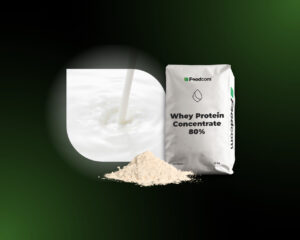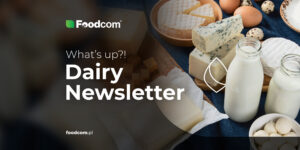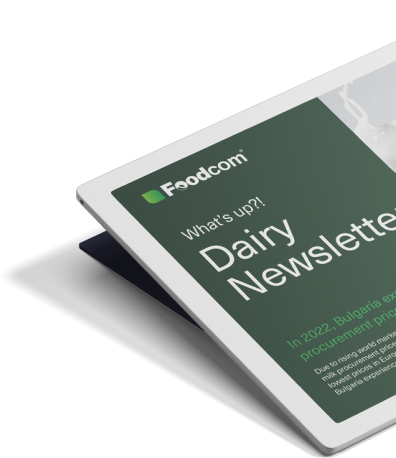- Cheese prices rose thanks to stronger export activity and limited availability at the end of the year.
- The fats segment, particularly butter and AMF, remains under downward pressure as a result of high cream supply.
- The protein and whey market maintains stable, high prices despite seasonal slowdown and global WPC/WPI shortages.
Welcome Partners!
Welcome back to our newsletter!
The dairy market continues to struggle with a high supply of raw material in Europe and worldwide. Milk production remains at elevated levels and trade activity gradually weakened at the end of the year. Exports are helping to relieve pressure on selected segments, especially cheese, but most products remain under pressure. We enter the final weeks of the year with low purchasing dynamics and increasing importance of contracts for Q1-Q2 2026.
Milk powder
The milk powder market is relatively stable, although sensitive to oversupply. Skimmed milk powder (SMP) is trading in the region of €2020-2100/MT, with occasional trades at lower levels for the older commodity. Export demand remains moderate.
SMP feed remains very quiet. Prices stable 2000-2060 EUR/MT and trade for the first months of 2026 is unchanged.
Whole milk powder (WMP) maintains a range of EUR 3200-3350/MT, although the global market remains weak and contract sales are clearly slowing at the end of the year.
Cheese
The cheese sector improved due to the pre-Christmas period and stronger export activity, which helped to reduce stock levels in November and December.
Gouda has returned to levels of around €3050/MT, with €3150-3300/MT seen in contracts for early 2026. The strong interest in Q1 and Q2 supplies is due to the expectation of a further drop in production costs early in the year.
Mozzarella has also strengthened, with quotes in the region of EUR 3000/MT. Limited cheese availability at the end of the year supports stabilisation.
Cheddar, on the other hand, remains one of the weakest segments. Inventory pressure and competition from external markets is keeping prices in the region of EUR 3350/MT.
Emmental continues its corrective trend, falling to around EUR 3850/MT, driven by high production and limited demand support after the end of quarterly purchases.
Overall, the cheese market remains more balanced than a month ago, although the outlook for the beginning of the year depends largely on export capacity and the continued ample supply of milk.
Fats
The dairy fats market remains weak. After a period of stabilisation, butter prices in Europe have moved downwards to €4700-4800/MT. Q1 contracts are trading near the bottom of the current price range.
Milk fat (AMF) remains in a gentle downward trend. Levels around 5700-5900 EUR/MT are seen in most trades, with limited demand for short-term supply.
High cream supply and moderate export trade are keeping pressure on fat prices.
Liquids
The market for liquid components remains very well supplied. Cream has cheapened again, reaching levels of EUR 5600-5700/MT, clearly lowering the theoretical fat values.
Milk concentrates have strengthened slightly. Skimmed milk concentrate (SMC) traded in the EUR 1350-1450/MT range, although earlier pre-Christmas trading was lower.
Whey concentrate remains stable at €650-750/MT, with processors working at high capacity utilisation.
Whey powder
The whey and dairy protein market remains one of the most stable segments. Feed whey remains in the EUR 980-1040/MT range and food whey in the EUR 1050-1100/MT range, with moderate but steady demand from both the food and feed industries. The availability of raw material is good and trade is proceeding without major changes.
Among protein concentrates, the situation also remains stable. WPC 35 is trading in the region of EUR 2,600/MT and WPC 80 maintains high levels around EUR 12,500/MT, sustained by continued demand from functional food manufacturers. WPI remains one of the most expensive protein components, exceeding EUR 20 000/MT.
Overall, the segment shows strong resilience to seasonal slowdowns. Stable prices indicate a balance between demand and supply in the coming weeks. However, this balance is being tested by external factors, such as the shortage of WPC/WPI in the US is having a noticeable impact on the market, causing prices to rise again.
What’s new?
Europe
Organic milk prices in Germany continue to grow rapidly, breaking records month after month. They reached a new peak again in September, for the sixth consecutive month, driven by stable demand and limited supply. Although organic milk production increased slightly year-on-year, the market remains under-supplied, giving producers a strong negotiating position. At the same time, conventional milk prices are weakening, widening the gap between the two categories and reinforcing the premium consumers are willing to pay for organic products. With the festive season approaching and the seasonal decline in milk production, the market could maintain high price levels or record further moderate increases, depending on how demand develops in the coming weeks.
Europe
A promising solution for mastitis prevention is emerging in dairy farming that reduces the use of antibiotics. The method is based on the use of antiseptic dips applied to the teats, and the first tests carried out on a herd of Holstein cows showed very encouraging results. For producers, this represents a potential breakthrough: a reduction of antibiotics in the herd, a response to the growing challenge of antimicrobial resistance, and an additional asset in building transparency and value in dairy products.
Europe
Lumpy Skin Disease (LSD) is causing the mobilisation of the Spanish veterinary services, which, with the approval of the European Commission, are extending the preventive vaccination programme to further areas of Catalonia and Aragon. The decision comes after 18 outbreaks were confirmed in the province of Girona and aims to secure previously disease-free zones by vaccinating herds in border areas and strengthening surveillance in surrounding areas. The Spanish Ministry of Agriculture has purchased more than one million doses of vaccine, of which nearly 400,000 have already arrived in the country, with the remainder to be delivered before mid-November. Around €660,000 has been allocated for emergency measures.
This development underlines the growing awareness of a regional risk: the threat is not exclusive to farms in the outbreak zone, but radiates to neighbouring regions, requiring a proactive approach with an emphasis on preventive vaccination rather than a mere response to cases already occurring.
![Cheese up, fats down – a dynamic week in dairy [289th Edition Foodcom DAIRY Newsletter] Cheese up, fats down – a dynamic week in dairy [289th Edition Foodcom DAIRY Newsletter]](https://foodcom.pl/wp-content/uploads/2023/08/Foodcom_SA_Whats_up_Dairy_Newsletter-1520x760.jpg)





